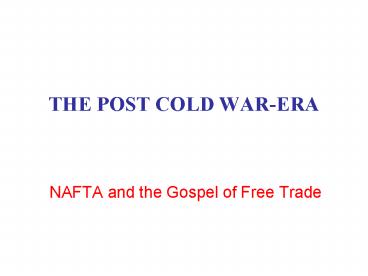THE POST COLD WAR-ERA - PowerPoint PPT Presentation
Title:
THE POST COLD WAR-ERA
Description:
THE POST COLD WAR-ERA NAFTA and the Gospel of Free Trade REQUIRED READING Smith, Talons, ch. 7 Course Reader #3, Blecker and Esquivel, NAFTA, Trade, and ... – PowerPoint PPT presentation
Number of Views:77
Avg rating:3.0/5.0
Title: THE POST COLD WAR-ERA
1
THE POST COLD WAR-ERA
- NAFTA and the Gospel of Free Trade
2
REQUIRED READING
- Smith, Talons, ch. 7
- Course Reader 3, Blecker and Esquivel, NAFTA,
Trade, and Development
3
PAPER ASSIGNMENT
- Topic Any subject related to U.S.-Latin
American relations (whether or not covered in
class)proposed by student and approved by TA - Examples Sports (e.g. baseball), film
(depictions of Latina women), - music (lyrics, popularity of stars, etc.),
advertising (Corona beer) - In-class examples Content of Latin American
nationalism, impacts of drug war (e.g., Plan
Colombia), reactions to 9/11, Bush relationship
with Latin leaders, Hugo Chávez phenomenon,
evaluations of NAFTA - Length 8-12 double-spaced pages (plus notes or
bibliography) - Due Monday, March 1
4
FORMAT FOR PAPER
- Introduce topic (and its importance)
- Present a central question
- Describe sources and methods (how will you answer
your question?) - Analyze information and data
- Conclusion
- Respond to your central question(s)
- Suggest avenues for further research
5
- AFTER THE COLD WAR
- THE GLOBAL ARENA
- Collapse of the Soviet Union
- U.S. military primacy the unipolar moment
- Economic multipolarity Europe, Japan, others?
- Transnationalization and non-state actors
- A third wave of democratization?
6
- DIMENSIONS OF UNCERTAINTY
- Distributions of power the layer cake model
- Absence of rules of the game
- Hesitancy in the United States
7
ON GLOBALIZATION
- Factors
- End of Cold Warreduction of political barriers
- Communication technologies
- Transnational enterprises production chains and
consumer markets - Movement of people and goods, legal and illegal
- Features
- Inexorability, inevitability
- Politics the result of economics
- Inclusion vs. exclusion?
- Claim no ideology
8
- THE 1990s GEO-ECONOMICS AND
- INTERMESTIC ISSUES
- Ideological consensus (or end of history?)
- Implausibility of revolution
- Fragmentation of Third World
- The rise of intermestic issues
- Free trade
- Drugs and drug wars
- Immigration
9
- THE GOSPEL OF FREE TRADE
- The Lost Decade (1980s) and Its Legacies
- Dynamics of the debt crisis
- The Washington Consensus
- The role of the state
- Liberalization of trade
- Privatization, the private sector, and foreign
investment
10
North American Free Trade (NAFTA)? Why? Why
Then? Global Scenario Economic multipolarity
(Japan, EU) Geopolitical uncertainty Emphasis on
geo-economics U.S. Perspectives Supplement
to FTA with Canada Support for neoliberal reforms
in Mexico Growing Mexican-American population
within U.S. Mexican Perspectives Exhaustion of
alternatives Need to stimulate growth Perpetuation
of Salinista policies
11
- NAFTA What Is It?
- A free trade area
- Not a customs union
- Nor a common market
- Characteristics
- Uneven levels of development
- Cultural and political variation
- Hub-and-spoke arrangements (with U.S. at center)
- Absence of supranational authority (preservation
of sovereignty)
12
- Assessing Results The Problem of
Cause-and-Effect - NAFTA in comparison with
- Initial expectations (and political rhetoric)
- Liberalization (mid-1980s)
- Global and/or U.S. economic conditions
- Long-term economic and social trends
- Short-term shocks (e.g., Mexican peso crisis of
1994-95)
13
Mexican Exports, 1985-2005(billions USD )
1985 27 bn, 1994 61 bn, 2205 214 bn
14
Expansion of Trade, 1993-2005(millions USD )
15
U.S. Trade with Mexico and Latin America,
1993-2005 (millions USD )
16
U.S. Imports Key Trading Partners, 1993-2005
(millions USD )
17
- Economic Performance Expansion of Trade
- General effects
- More efficiency (in production and consumption)
- Greater market size (thus higher returns)
- Tougher competition
- Questions
- Who takes part in the trade? (55 large firms,
40 maquiladoras, gt 5 small firms ( 2.1
million firms) - What about trade diversion?
18
Foreign Direct Investment in Mexico, 1980-2004
19
GDP Growth in Mexico 1945-1980 6.5 1995
-7.0 1996 5.1 1997 6.8 1998 4.9
1999 3.8 2000 6.6 2001 -0.2 2002
0.7 2003 1.5 2004 4.6 2005 2.8
2006 5.0 2007 3.2 2008 1.3 2009
-6.8 Note Growth does not necessarily reduce
poverty, and often increases inequality.
20
Unforeseen Shocks Mexican peso crisis of
1994-95 September 11, 2001 Current
Challenges Expansion of the development
gap Infrastructure (including roads) Migration Ene
rgy Macroeconomic policy (thus dollarization?) S
ecurity problems
21
- Key Points of Disputation
- Environmental protection
- Labor rights
- Overall development strategy
- Dependence on United States
- Consolidation of U.S. hegemony
22
POLITICAL EFFECTS
- The Public Assertion Free Trade Democracy
- The Silent Bargain International Dimensions
- Political stability and social peace
- Access to petroleum
- Leverage vis-à-vis economic rivals
- Compliance on foreign policy
23
Political Consequences (1)
24
Political Consequences (2)
25
- Now What?
- Routes toward Hemispheric Integration
- Expansion of NAFTA (through new memberships)
- FTAA negotiating process
- Bilaterals and minilaterals
- U.S.-Chile
- U.S.-Central America
- U.S.-Peru
- U.S.-Colombia (?)































